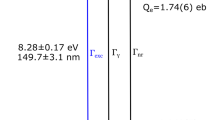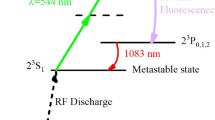Abstract
For a number of years we have been examining the ability to partition the chemical reaction energy directly into electronic transitions. The obvious advantage with this approach is that energy, which comes basically from chemistry, is partitioned directly into electronically excited states rather than going through an electrical power generation step with its associated inefficiencies. The disadvantage of such pumping schemes is that the excitation energy is limited to that of the chemical bond, 3 to 4 ev. Thus, unless multiple collisions are invoked, only electronic states below 4 ev could be pumped by such energy partitioning.
Access this chapter
Tax calculation will be finalised at checkout
Purchases are for personal use only
Preview
Unable to display preview. Download preview PDF.
Similar content being viewed by others
References
R. G. Derwent and B. A. Thrush, Trans. Faraday Soc., 53; 162 (1972) and references within
D. F. Muller, R. H. Young, P. L. Houston, and J. R. Wiesenfeld, Applied Physics Letters, 38;404 (1981) and references within
P. Alsing, G. Simmons and S. Davis (Air Force Weapons Laboratory), in publication (1982)
R. Heidner, C. E. Gardner, G. I. Segal and T. M. El-Sayed, submitted to J. Phys Chem, (1982)
H. Lilenfeld, McDonald Douglas Research Labs, unpublished work (1982)
D. F. Muller and P. L. Houston, J. Phys Chem, 85; 3563 (1981)
J. M. Herbelin and N. Cohen, Chem Phys Letters, 20; 605 (1973)
C. T. Cheah and M. A. A. Clyne, Journal of Photochemistry, 15; 21 (1981)
A. T. Pritt, Jr. and R. D. Coombe (Air Force Weapons Lab), TR-81-2111 (1981) and Int J.Chem Kinetics, 12; 741 (1980)
J. M. Herbelin, M. A. Kwok and D. J. Spenser, J. Appl Phys, 49; 3750 (1978)
S. J. Davis and L. Hanko, Appl Phys Lett, 37; 692 (1980)
P. D. Whitefield, R. F. Shea and S. J. Davis, submitted to J. Chem Phys (1982)
P. D. Whitefield and S. J. Davis, Chem Phys Lett, 83; 44 (1981)
T. Trickl and J. Wanner, J. Chem Phys, 74; 11 (1981)
J. Valentini, M. J. Coggiola and Y. T. Lee, Int J. Chem Kinetics, 8;605 (1978) and references within
R. D. Coombe and R. K. Horne, J. Phys Chem, 83; 2470 (1979)
M. Diegelman, K. Tbhla, F. Rebentrost and K. L. Kompa, J. Chem Phys, 73; 1233 (1982)
A. T. Pritt and F. J. Wodarczyk, Rockwell International Science Center, private communication (1982)
A. T. Pritt, D. Patel and R. D. Coombe, J. Mol Spec, 87; 401 (1981)
W. Hack and O. Horie, Chem Phys Letters, 82; 327 (1981)
Author information
Authors and Affiliations
Editor information
Editors and Affiliations
Rights and permissions
Copyright information
© 1984 Plenum Press, New York
About this chapter
Cite this chapter
Avizonis, P.V. (1984). Chemically Pumped Electronic Transition Lasers. In: Onorato, M. (eds) Gas Flow and Chemical Lasers. Springer, Boston, MA. https://doi.org/10.1007/978-1-4615-7067-7_1
Download citation
DOI: https://doi.org/10.1007/978-1-4615-7067-7_1
Publisher Name: Springer, Boston, MA
Print ISBN: 978-1-4615-7069-1
Online ISBN: 978-1-4615-7067-7
eBook Packages: Springer Book Archive




